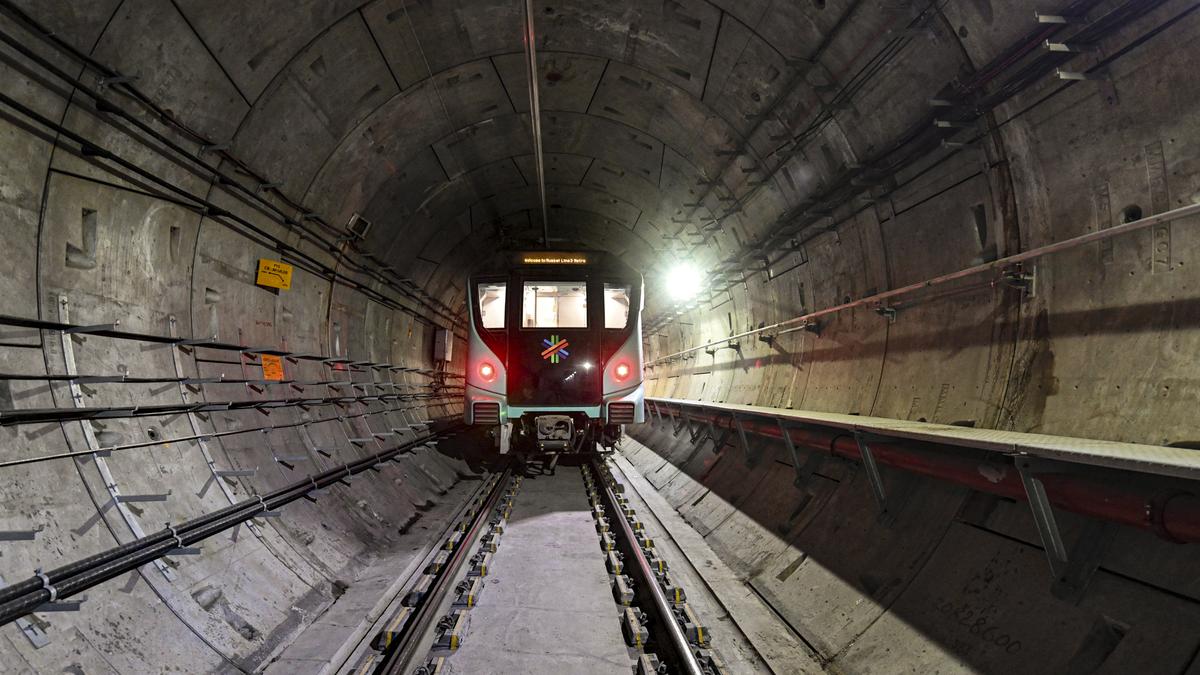By Prime Minister Narendra
Copyright thehindu

Prime Minister Narendra Modi on Wednesday (October 8, 2025) inaugurated the final phase of Mumbai’s first fully underground Metro 3, making 33.5-km Aqua Line operational, which will connect Aarey in the north to Colaba in the south of Mumbai, aiming to ease congestion on suburban trains and roads.
The final stretch spans around 11.2 km from Acharya Atre Chowk in Worli to Cuffe Parade, providing connectivity with six business centres, including Nariman Point, Cuffe Parade, Fort, Lower Parel, BKC and SEEPZ/MIDC.
According to Mumbai Metro Rail Corporation (MMRC), the stretch will directly connect South Mumbai with Central Mumbai and link areas such as Kalbadevi, Girgaum, Worli, international and intra-state airports, which are not linked with Mumbai’s lifeline railway network.
Also Read | PM Modi inaugurates phase one of Navi Mumbai International Airport
“The total travel time from North to South will take less than one hour and connect atleast 30 educational institutions, 13 hospitals, 14 religious places and over 30 entertainment facilities. We expect 15% of suburban railway traffic to be on Metro 3, easing the burden on the railways,” an official at MMRC said.
The trains will run every five minutes during peak hours; in total, 280 train trips will be made on the fully operational underground Aqua Line.
Currently, on average, 70,000 commuters travel every day on the operational part of the line. With the complete line in service, the MMRC expects 1.3 million passengers commuting daily. The first two phases cover 22.3 km of total line, connecting Aarey and Worli. The first phase from Aarey to BKC (12.6 km) was inaugurated on October 7, 2024, while the second phase- BKC to Acharya Atre Chowk station (9.7 km) was inaugurated on May 9, 2025.
According to MMRC, the Aqua Line 3 will have interchanges with the elevated Pink Line 6 (Swami Samarth Nagar- Vikhroli) at Aarey station, Blue Line 1 (Ghatkopar- Versova) interchange at Marol Naka station, proposed Gold Line 8 at CSMI Airport T2 station, under-construction Yellow Line 2B at BKC and more. The line runs parallel to the railway network of Mumbai, further making it easy to transport and connect to the Bullet Train in the future.
The project completion took nine years; it was first commenced in January 2017, with tunnelling completed in November 2022. The line connects important industrial and commercial hubs, including Nariman Point, Cuffe Parade, Fort, Lower Parel, BKC, and SEEPZ. The line also helps commuters from North and South Mumbai to access Chhatrapati Shivaji Maharaj International Airport (CSMIA) through Metro 3. The total cost of the project has been ₹37,276 crore. The minimum fare starts from ₹10 to ₹70.
According to MMRCL, the project also consists of environmental benefits, claiming that the daily trips of 6.5 lakh vehicles will decrease, fuel consumption of vehicles will be reduced by 3.54 lakh litres per day, and road traffic will be decreased by 35%.
The first phase, having 10 stations connecting Aarey with BKC, while the second phase connects important places of worship, including Shitala Devi Temple, Siddhivinayak, and Dharavi, the largest slums of India, while the last phase will have the Science Museum, Mahalaxmi, Jagannath Shankar Sheth (Mumbai Central), Grant Road, Girgaon, Kalbadevi, CSMT, Hutatma Chowk, Churchgate, Vidhan Bhavan, and Cuffe Parade.
After the first phase became operational, 41,66,363 (from implementation till 03 May 2025) passengers commuted. The travel time from Aarey to BKC is 22 minutes, from BKC to Acharya Atre Chowk is 15 minutes 20 seconds, while Aarey JVLR to Acharya Atre Chowk is 36 minutes.
The stations of the first two phases have 208 escalators and 67 lifts, and 2447 CCTV cameras are continuously monitoring the Metro 3 stations.
Metro 3 has faced several controversies, including the acquisition of the Aarey forest land for the car shed, project cost escalation and monsoon flooding issues.